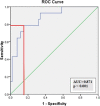Predictors and Outcomes of Pancreatic Fistula Following Pancreaticoduodenectomy: a Dual Center Experience
- PMID: 33814828
- PMCID: PMC7960792
- DOI: 10.1007/s13193-020-01195-3
Predictors and Outcomes of Pancreatic Fistula Following Pancreaticoduodenectomy: a Dual Center Experience
Abstract
Fistula following leaked pancreatico-enteric anastomosis is a common, potentially lethal complication of pancreaticoduodenectomy (PD). Early assessment and prediction of its occurrence can improve postoperative outcomes. Various perioperative factors were analyzed for its contribution to clinically relevant postoperative pancreatic fistula (crPOPF). Also, the difference in clinical outcomes of patients with and without fistula was studied. Sixty-seven patients undergoing PD for malignancies were analyzed during 3-year period in a dual-institutional study. Various preoperative, intraoperative, and postoperative factors were assessed. The incidence and severity of POPF and its association with the development of other post-PD complications were observed. Patients with and without POPF were divided into groups and compared with univariate and multivariate analyses, to identify significant contributing factors. Clinically relevant POPF was present in 20.9% cases. crPOPF contributed to delayed gastric emptying, albeit insignificant (p = 0.403), but was significantly associated with increased incidence of post-pancreatectomy hemorrhagic (p = 0.005) and infectious complications (p = 0.013). Soft pancreas (p = 0.024), intraoperative blood loss (p = 0.045), blood transfusion (p = 0.024), and fistula risk score (p = 0.001) were significant predictors of crPOPF. First postoperative day (POD1) drain fluid amylase (DFA) values at cut-off of 1336 U/L (AUC = 0.871; p < 0.001) significantly predicted crPOPF with good sensitivity and specificity. POD1 DFA was only factor significant on multivariate analysis (p = 0.014). There was no significant difference in overall survival between groups. crPOPF results in significant post-pancreatectomy hemorrhagic and septic complications, along with increased mortality. It can be accurately predicted by several preoperative and intraoperative factors. POD1 DFA can independently predict crPOPF development.
Keywords: Clinically relevant POPF; Complications; Periampullary cancer; Whipple’s procedure.
© Indian Association of Surgical Oncology 2020.
Conflict of interest statement
Conflict of InterestThe authors declare that they have no conflicts of interest.
Figures
References
-
- Conzo G, Gambardella C, Tartaglia E, Sciascia V, Mauriello C, Napolitano S, Orditura M, de Vita F, Santini L. Pancreatic fistula following pancreatoduodenectomy. Evaluation of different surgical approaches in the management of pancreatic stump. Literature review. Int J Surg. 2015;21:S4–S9. doi: 10.1016/j.ijsu.2015.04.088. - DOI - PubMed
-
- Bassi C, Dervenis C, Butturini G, Fingerhut A, Yeo C, Izbicki J, Neoptolemos J, Sarr M, Traverso W, Buchler M, International Study Group on Pancreatic Fistula Definition Postoperative pancreatic fistula: an international study group (ISGPF) definition. Surg. 2005;138(1):8–13. doi: 10.1016/j.surg.2005.05.001. - DOI - PubMed
LinkOut - more resources
Full Text Sources


